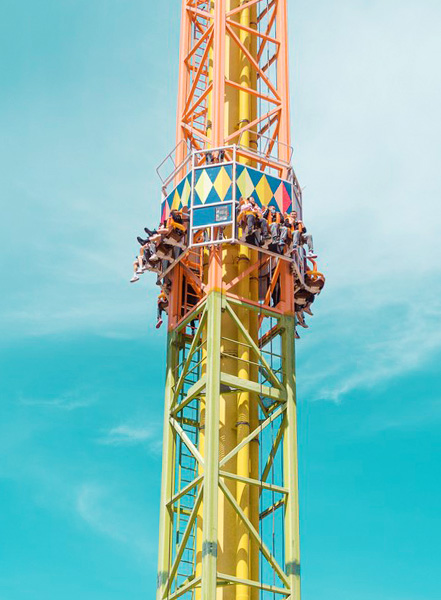Operating a drop tower ride requires far more than pushing a button and watching passengers scream with delight. Behind the scenes, precise technical know-how, safety procedures, and training protocols form the backbone of a successful and responsible ride operation. For anyone exploring drop tower rides for sale (аттракцион свободное падение), understanding operational requirements is not optional—it’s a non-negotiable part of long-term performance, safety, and legal compliance.
This article delves into the crucial knowledge areas every buyer should master when investing in a drop tower, with comparisons to other popular amusement rides like the Ferris wheel and pendulum ride, highlighting the unique challenges and responsibilities involved.
Why Ride Familiarity Is A Must For Park Owners
Operating Without Knowledge Leads to Risk
Many buyers, especially those new to the industry, assume that running a drop tower is straightforward. However, these rides involve complex mechanical and electronic systems. Incorrect operation can lead to severe malfunctions, shutdowns, or even passenger injuries. Unlike the more passive operation of a Ferris wheel (колесо обозрения), drop towers demand precise control of timing, pressure systems (hydraulic or pneumatic), braking sequences, and emergency stop procedures.
Without training or technical documentation, your staff may be ill-equipped to respond to unexpected scenarios such as sensor errors, power fluctuations, or mechanical delays. This lack of preparedness can quickly escalate into dangerous situations.
Learn Before You Launch
When considering any drop tower ride for sale, ask the supplier if they provide an operating manual, instructional videos, or on-site training. These resources are essential to familiarize your team with every aspect of the ride’s functionality—from system startup to emergency protocols. The learning process may take days or even weeks, depending on ride complexity.
Compare this with the pendulum ride, which, although thrilling, typically runs on a set motion algorithm with limited operator interference once initiated. In contrast, a drop tower operator must actively monitor the control panel, brake status, and seat restraints in real time.
What Training Programs Should Include
Component-Level Understanding
To safely operate a drop tower, your team should understand the core components:
- Winch or lifting system – Raises the platform
- Free-fall trigger mechanism – Releases the carriage
- Braking system – Controls the deceleration
- Control console – Manages timing, safety checks, and system diagnostics
Each part should be checked daily before the ride begins operation. Proper knowledge of these systems ensures the ride can be reset or shut down safely in emergencies.
Safety Drills and Emergency Scenarios
Operators should undergo routine drills to prepare for scenarios such as:
- Sudden power outages
- Passenger restraint failures
- Manual override usage
- Communication during malfunctions
Unlike passive attractions like the Ferris wheel, which can often be manually rotated or slowly offloaded in emergencies, drop towers require precise and immediate action.
Some manufacturers offer in-person training or virtual simulation software. Investing in these services pays off by reducing downtime and avoiding operator error.
Legal and Insurance Responsibilities
Regulatory Compliance Varies By Region
Every region has its own regulations for amusement rides. Depending on your location, the ride operator may need to be licensed or certified. Without proper training, insurance claims may be denied in the event of an accident. This is especially critical with high-risk attractions like drop towers.
Before purchasing a ride, consult local regulatory bodies to understand requirements for:
- Operator certifications
- Ride inspections
- Maintenance logs
- Emergency response planning
While rides like the pendulum ride or Ferris wheel may fall under the same jurisdiction, the rapid vertical motion of drop towers often puts them into higher-risk categories, triggering more stringent rules.
Ensuring Long-Term Success Through Training
Maintenance and Troubleshooting Skills
Your operations team should also be trained to perform basic troubleshooting. A delay in diagnosing a small issue—such as a misaligned safety sensor—can shut the ride down for hours. Over time, these delays translate into lost revenue and poor customer experiences.
Technicians should understand how to:
- Perform diagnostic tests using onboard systems
- Reset the control unit safely
- Inspect and replace worn components
- Maintain detailed logs for regulatory audits
Building a Ride-Specific Operating Manual
Even if your drop tower ride comes with a general manual, consider creating a customized guide tailored to your site. Include:
- Local emergency contacts
- Specific start-up and shut-down procedures
- Operator checklists
- Photos of your actual unit for reference
Encourage operators to contribute to this manual as they gain more experience. Over time, this becomes an invaluable resource for training new staff and maintaining consistent operations.
Conclusion: Safety and Expertise Go Hand-in-Hand
Buying a drop tower ride for sale is only half the equation. True success lies in how well you operate, maintain, and respond to the unique challenges these vertical thrill machines present. Compared to smoother, slower-paced rides like the Ferris wheel, or the rhythmic sway of a pendulum ride, drop towers require real-time attention and quick decision-making.
By investing in proper training, familiarizing yourself with technical components, and establishing safety-first protocols, you don’t just buy a ride—you invest in an unforgettable, safe experience for every rider.

